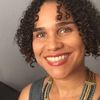Trying to break into publishing can feel like having a door slammed in your face over and over again. As a black child growing up on the outskirts of Toronto, I used to dream about doors--magical portals that opened onto distant lands. Even though all the books I read featured children who looked nothing like me, I still believed something remarkable could happen if only I found the key...
By the time I left Toronto in 1994, I no longer believed anything magical would ever happen to me there. After spending one summer in Brooklyn with my father, I knew where I belonged: I became an immigrant and my transplanted dreams took root here in the US instead. I entered graduate school at NYU and taught part-time in community centers, museums, and after-school programs throughout the city. I loved my students and I was invested in my scholarship on racial violence, but what I really wanted to do was write. I left graduate school in 1998 and finished the novel I had started five years earlier. I sent out query letters to agents and editors and got a very encouraging response. But half a year passed and I still couldn't find the key. The doors to the publishing world remained closed.
Ten years passed. My knuckles and my ego were bruised. I earned my PhD in American Studies and managed to publish some poems and essays. I even won Lee & Low's New Voices Honor Award in 2006 for my picture book, Bird. I thought for sure that shiny, silver sticker on my beautiful book would serve as a beacon for all those editors and agents who claimed they were desperately searching for talented black authors. Bird garnered more honors and awards, but no one rushed to snatch up my twenty unpublished picture book manuscripts. I had a hard drive full of finished work: in addition to that first novel, I had written a middle grade novel, a young adult novel, a memoir, and nearly twenty plays of various lengths.
The turning point came when I ran into a friend at the Brooklyn Museum. Pam and I had talked before about striking a balance between our creative work and the various commitments required of academics. An accomplished playwright and scholar, Pam was someone I admired. So when she said I should look into Lulu.com, I listened. "Who are we waiting for?" she asked.
Well, the truth is, many of us were waiting for some editor somewhere to make us "legitimate" by giving us the official stamp of approval. I didn't know anything about publishing on demand, but I did once think that self-publishing was for desperate people who lacked the talent to get picked up by a traditional publisher. Would I ruin my chances with "a real press" if I went the self-publishing route? In the end, I decided to put together four books: my memoir, Stranger in the Family, my young adult novel, A Wish After Midnight, and two collections of plays. Shadra Strickland, award-winning illustrator of Bird, designed the covers of Stranger and Wish; another friend designed my website, I started to blog, I made a book trailer, and a new, more public phase of my writer's life began.
In early 2009 I decided to switch from Lulu to Create Space; my four titles were assigned ISBNs and were now available on Amazon.com. Whenever I gave a presentation on Bird, I made sure to have a copy of my other books on hand; I networked with local educators and librarians--by spring, both the Brooklyn Public Library and the New York Public Library agreed to add Wish to their collections. I made up postcards and a press kit, started an imprint (Rosetta Press), and established a relationship with Baker & Taylor. The most important step, however, was getting Wish reviewed. I sent out a LOT of review copies and press kits; several bloggers who knew my name because of Bird were willing to give Wish a chance, and they were the key to my success.
Wish made it onto the radar of an acquisitions editor from AmazonEncore, and by the time he contacted me in July 2009, I had met my two primary goals: Wish was available in public libraries, and local schools were starting to adopt the book. What AmazonEncore offered was a new kind of partnership that would build on the foundation I had laid as a self-published author (I ultimately sold over 400 copies). My novel would not be edited or changed in any way, but it would get a new cover and a HUGE push from AmazonEncore's marketing team--Wish would be available as a paperback book (in all bookstores and on Amazon's global websites), on Kindle, and possibly also as an audio book on Audible.com.
Do I feel vindicated? Somewhat. I still don't have a home for many of my manuscripts for children, though AmazonEncore's interested in the sequel to Wish, which I'm writing now.
Do I feel empowered? Yes! Remember that line from The Sound of Music: "When God closes a door, somewhere He opens a window"? Writers today have options. We don't have to wait for someone else's stamp of approval, and we no longer have to personalize rejection by mainstream publishers. Kyra Hicks, another self-published author, introduced me to the Cooperative Children's Book Center. They keep statistics on the number of books published annually for children, and the results speak for themselves: in 2008, out of an estimated 5,000 books, less than 90 were by black authors. I have fussed and fumed, I have posted an "Open Letter" to the children's publishing industry on my blog. I can't force mainstream publishers to open their doors to me, but the industry will be transformed whether they like it or not, and I intend to participate in that transformation.
